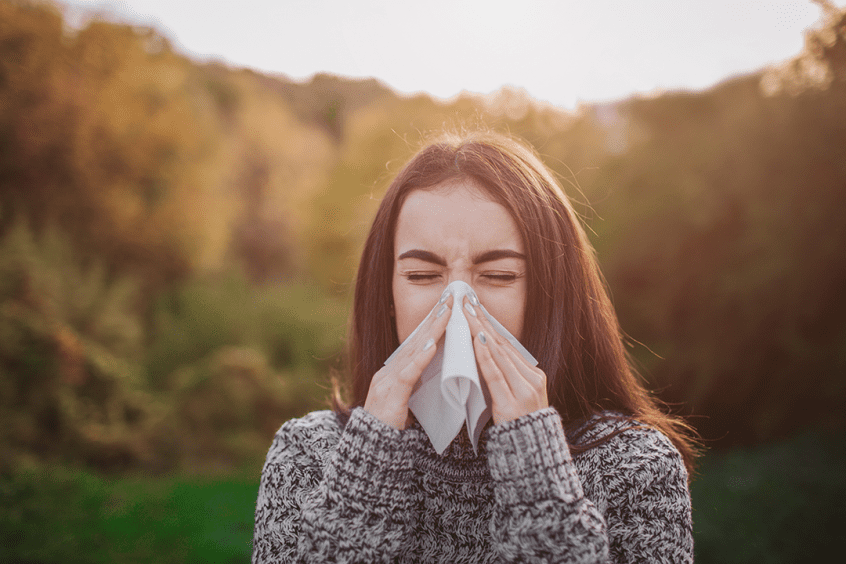Common Fall Allergies and How to Fight Them

Just when you thought you were through dealing with allergies, here comes fall to rain on your parade. Although triggered by some slightly different things, fall allergies are just as common – and just as annoying – as spring allergies.
However, like spring allergies, the causes can be easily identified and dealt with. So, to save you from excessive coughing and sneezing this fall, here are some of the most common fall allergies and how to deal with them. For indoor air quality solutions to help fight indoor allergens, contact Chapman Heating, Air Conditioning & Plumbing today.
Ragweed
Although pollen is definitely more of an allergy concern in the spring, there is one plant in particular that wreaks havoc during the fall: ragweed.
High pollen counts for ragweed peak in late August through September and can cause headaches, sneezing, runny nose, itchy and watery eyes and more. These fall allergy symptoms are commonly referred to as “hay fever.â€
How to Avoid It
The best way to avoid pollen allergies in fall is to keep your windows closed as often as possible. Sure, the cool weather may make it tempting to open up your car and home windows, but the more they are open, the better chance they have of making their way into your home.
Pollen can also cling to your clothes and shoes if you spend a good deal of your day outdoors. An outdoor mat to wipe your feet off with is a good way to keep them out as well as regularly washing your clothes.
Ultimately, the less that you are exposed to ragweed and the pollen that comes with it, the less fall allergy symptoms you will experience.
Pet Dander
Pet dander is one of the hardest allergy causers to deal with. Some pets constantly shed and make dealing with hair and dander a real nightmare. Pet dander can also get everywhere: underneath the furniture, behind cabinets, on your clothes, on your furniture, etc.
Unchecked pet hair and dander, even for those who aren’t particularly allergic, can cause coughing and sneezing throughout the house.
How to Avoid it
The best way to keep pet dander at bay is to frequently vacuum, making sure to get behind cabinets and under furniture. Make sure no stone is left unturned! In order to lower levels of pet dander, it’s crucial to get the pet dander out from all the potential hiding spots. You can also help limit the spread by keeping pets off of furniture and beds as much as possible.
Also, be sure to frequently brush cats and dogs – outside if possible – to remove any shedding or loose hair. Regular bathing can also help in the removal of loose hair and dander.
Dust Mites
These microscopic critters are one of the most common triggers for seasonal allergies. They feed on the tiny flakes of dead skin that humans produce every day and are almost impossible to completely get rid of because they can work their way deep into the fibers of your furniture.
While they are almost ever present, the waste they produce is a common allergen for many people and can cause sneezing, coughing and other fall allergy symptoms. Dust mites are also known to trigger symptoms for those with asthma.
How to Avoid it
While they are tremendously difficult to remove, there are some easy ways to keep them at bay. Despite what their name may imply, dusting and vacuuming alone is not enough to remove them. Regular washing of bed sheets with hot water will remove excess skin build-up and keep them away. In cases of severe allergies and asthma, it may also be wise to invest in a mattress cover to prevent them from finding their way into the fibers.
Dust mites thrive in 70 to 80 percent humidity levels, so one of the best ways to reduce their numbers is to reduce humidity levels in your home. When using your air conditioner or dehumidifier, keep humidity levels around or below 50 percent.
Mold & Mildew
Mold and mildew build-up, like dust mites, is another allergy trigger in the fall. Mold and mildew can grow in areas of your home that are prone to moisture and humidity such as basements, attics, laundry rooms and bathrooms.
Those with mold and mildew allergies have symptoms very similar to hay fever and can also trigger asthma. Fortunately, mold and mildew are a lot easier to prevent and address.
How to Avoid it
If you stay attentive and alert, you can eliminate all causes of mold and mildew throughout your house. Keeping humidity levels low are key, especially in basements and attics, so make sure your dehumidifier is turned on.
Bathrooms can be the most troublesome areas, but making sure you have fans running during showers and baths will help remove moisture in the air. Fixing any leaks in your plumbing will also help keep excess moisture at bay. The less moisture in the air, the less likely that you’ll develop cases of mold and mildew.
Contact Chapman’s for Indoor Air Quality Solutions
If you need help eliminating allergens this fall, contact Chapman Heating, Air Conditioning & Plumbing today! We have a full line of indoor air quality solutions to keep your home’s air supply clean and healthy.





